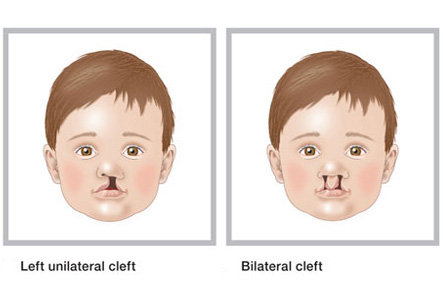Cleft Lip and Palate
Introduction
Cleft lip and cleft palate are congenital facial and oral malformations of newborn. They occur very early in pregnancy, when the baby is developing in the uterus of the mother. Clefting can result when there is not enough tissue formed in the mouth or lip area, and if there is problem in joining of the tissues available.
A cleft lip presents as a physical split or separation between the two sides of the upper lip and appears as a gap in the skin of the upper lip. This separation can extend beyond the base of the nose and can include the bones of the upper jaw.
A cleft palate is a split or opening in the roof of the mouth which can communicate with the nasal cavity. There are two parts of palate, the hard palate or the bony front portion of the roof of the mouth and the soft palate or the soft back portion of the roof of the mouth. Cleft palate can involve one or both of these.
The cleft lip and cleft palate can occur alone or in combination as both these parts develop separately in the fetus.
Iranian specialists have made remarkable achievements in infants' surgeries and Iran is among few countries that have gained access to the latest surgical technologies

Causes of Cleft Lip and Cleft Palate
1. In most cases, the cause of cleft lip and cleft palate is unknown. Therefore there is no method to prevent them. They are postulated to occur due to a combination of genetic as well as environmental factors.
2. If a sibling, parent or relative has clefting, there are chances of a newborn being born with these disorders in such families.
3. Another potential cause may be medications taken by mother during her pregnancy. These drugs include anticonvulsant drugs, retinoids for treating acne, and methotrexate used in treating cancer, arthritis, and psoriasis.
4. Certain viruses and chemicals can also cause damage to the fetus leading to these conditions.
5. In some situations, cleft lip and cleft palate may be part of other medical conditions.
Diagnosis
The cleft lip and cleft palate can occur alone or in combination as both these parts develop separately in the fetus.
As there are obvious physical changes in a cleft lip or cleft palate, they are easy to diagnose clinically. Before birth, clefting can be diagnosed by ultrasound of mother during pregnancy. After birth, a proper physical examination of the mouth, nose, and palate confirms the presence of cleft lip or cleft palate. Diagnostic tests may be ordered by the physician to rule out the presence of associated congenital anomalies.
Problems or symptoms Associated with Cleft Lip and Palate are:
1. Eating and feeding problems-As there is opening in the palate, food and liquids can pass from the mouth into the nasal quality. This problem can be treated by specially designed bottles and nipples which maintain the flow of fluids toward the stomach. Also artificial palate can be worn by children to help them eat properly. This ensures adequate nutrition until correction of cleft by surgical methods.
2. Ear problems- Children with cleft palate are exposed to risk of ear infections since there can be accumulation of fluid in the middle ear. This can lead to hearing loss if not treated in time. Special tubes are placed in the eardrums to help the fluid drainage to prevent infections. Hearing should be tested at least once a year.
3. Speech problems-Articulation of speech is defective. This means the voice of the child is not carried well out of mouth. The voice may become nasal or the speech may be difficult to understand. Corrective surgery can fix these problems in some cases. A doctor specialized in speech therapy can help the child to resolve these speech difficulties.
4. Dental Problems- Children with clefts have various dental problems such as cavities, missing tooth, malformed or displaced teeth. This requires dental and orthodontic treatments. There may be an alveolar ridge defect. The alveolus is the part of jaw bone that contains teeth. This defect can displace or rotate the permanent teeth or prevent permanent teeth from appearing. These problems can usually be repaired through oral surgery.
Treatment for Cleft Lip and Cleft Palate
1. A cleft lip requires one or two surgeries depending on the extent of the defect. The appropriate time for surgery is usually after 3 months of age.
2. Repair of a cleft palate often requires multiple surgeries may be till 18 years. The time for first surgery to repair the palate is between 6 and 12 months old. The initial surgery is important to create a functional palate, reduces the chances of ear infection, and also helps in the proper development of the teeth and facial bones.
3. A bone graft may be needed in the palate to fill the gap in upper gum line to support and stabilize the permanent teeth after about 8 years of age.
4. Additional surgeries may be needed to improve speech, appearance of nose and lip, breathing as well as for realigning the jaw.
5. After eruption of permanent teeth, braces are often needed to straighten the teeth. Dental reference is needed for care of teeth.
Results of treatment
The treatment for a cleft lip and/or cleft palate can extend over several years and usually requires several surgeries depending on the condition. However, most children affected by this condition can achieve normal appearance, speech, and eating.